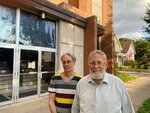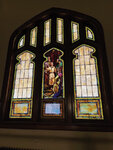

For 70 years, Eric Johnson has lived in the shadow of Bethany Church, but that shadow may soon disappear if the building’s current owner, Augsburg University, moves ahead with plans to demolish the historic structure at the corner of Franklin and 25th Avenue.
Johnson and a group of his neighbors want to stop that from happening.
“Bethany has played such an important role in the life of this community. It needs to be preserved. We can’t lose it,” Johnson maintains.
Joel Albers, a long-time Seward activist, shares Johnson’s concerns. “Bethany is a sacred place. It was founded by Scandinavian immigrants, whose culture did so much to shape this city’s character. The building is a local landmark, but the church is much more than a building. Bethany has long served as a safe space, welcoming, caring and healing the people of this community, particularly its new arrivals.”
Bethany traces its origins back to 1902, when its Norwegian Lutheran congregation began building a new home on its current site, only to see the building destroyed by fire. The church was rebuilt and held its first service in 1918. But like many inner-city congregations, Bethany faced dwindling resources and a shrinking membership roll in recent years. In 2021, the congregation voted to disband and gift its building to Augsburg University.
After the school took over management duties, several community-based programs continue to occupy the Franklin Avenue building. They included a unique food program known as Soup for You, and the Minnesota Chapter of the Center of Islamic-American Relations. But those organizations were forced to relocate earlier this year when Augsburg closed the building and made plans to sell the property. One prospective buyer is the Somali Museum of Minnesota, now located on East Lake Street. The museum wants to build a new facility on the Bethany site.
Albers and his group hope to hold off demolition by obtaining designation for Bethany as an official historic landmark by the Minneapolis Historic Preservation Commission. Designation, in and of itself, does not prevent demolition of historic sites, but it does require an extensive evaluation by the commission before the city can issue a demolition permit. The group working to preserve Bethany also hopes to get a large swath of Seward, which includes Bethany and several other nearby churches, declared an historic district.
If his group succeeds in obtaining landmark designation for Bethany, Albers knows the building needs about $3.8 million in deferred maintenance before it can be put back into productive use. “That is a significant amount, but it is nowhere near the $20-$30 million needed to demolish the existing church and build a new structure on the site.”
The Seward preservationists have not yet put together an operating plan for a newly reconfigured Bethany but there are several models they could follow, according to Albers. One could replicate the plan in place for the Walker Methodist Church in Powderhorn Park.
There, the church building, now called the New City Center for Healing Justice, is managed by a nonprofit collective called Grapevine. The collective draws on volunteer labor to help defray the cost of maintaining the center, which houses several non-profit organizations, including the Walker congregation.
Albers and Johnson know they face serious challenges as they move ahead to preserve and repurpose Bethany while maintaining its service role. But they are encouraged by the strong support they are receiving from the Seward community.
“Too often in the past, historic buildings have been demolished. Then, in later years, the people of Minneapolis have come to regret that action.” Johnson notes. “The Metropolitan Building, which succumbed to the wrecking ball in 1961, is a good example. Bethany Church may not be another Metropolitan Building, but it has a rich history. Let’s not make the same mistake with our own historic building that Minneapolis made with the Metropolitan.
“If we do, I know we will come to regret it.”
Comments
No comments on this item Please log in to comment by clicking here